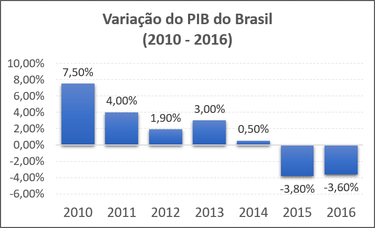2014 Brazilian economic crisis
.jpg)

Brazil was experiencing an economic crisis, which started in mid 2014 and ended in 2016.[2][3] The economic crisis is coupled with a political crisis in Brazil that resulted in the impeachment of president Dilma Rousseff and in widespread dissatisfaction with the political system.
In 2015, Brazil's gross domestic product (GDP) fell by 3.9% due to a drop in salaries, restrictions on credit and a rise in the basic interest rate. In 2016, Brazil's GDP fell by 3.6% with reductions across all sectors of the economy. It was the first time since 1931 that the GDP had fallen in two consecutive years. In 2017 first quarter the economy up 1.4% and the recession had finally ended. [4]
Unemployment
Before the recession, Brazil's unemployment rate hovered around 6.8% for most of 2014 and had been generally increasing since February 2015, averaging 8.5% in 2015. The economy lost more than 1.5 million jobs throughout 2015, fueling public discontent against the political establishment and the political leadership of the Worker's Party and President Dilma Rousseff.[5] The unemployment rate continued to rise throughout 2016 to finish the year at 12.0%, with 12.3 million people unemployed and an estimated 2.8 million private sector jobs cut over the preceding two years.[6]
Budget deficit
Brazil is currently experiencing a fiscal crisis and an increasing budget deficit which, according to Bloomberg, has been "the largest-ever primary budget gap ... as a two-year economic recession sapped tax collection while expenses grew further."[7] The government deficit reached 5.8 billion reais (U$1.7 billion) in the first three months of 2016, the widest reported since December 2001. The two-year fiscal deterioration can be explained by the decrease in government revenue from taxes as a result of the recession, while expenses from government have been growing constantly.[8]
Credit rating
This is a table of the credit ratings of the Brazilian economy according to Trading Economics.
| Agency | Rating | Outlook | Date |
|---|---|---|---|
| Fitch | BB | negative | May 5, 2016 |
| TE | 34 | negative | Apr 16 2016 |
| Moody's | Ba2 | negative | Feb 24 2016 |
| S&P | BB | negative | Feb 17 2016 |
Inflation
| Inflation Rate by Year[9] | |
|---|---|
| Year | Inflation Rate (IPCA) |
| 2002 | 12.53% |
| 2003 | 9.30% |
| 2004 | 7.60% |
| 2005 | 5.69% |
| 2006 | 3.14% |
| 2007 | 4.46% |
| 2008 | 5.91% |
| 2009 | 4.31% |
| 2010 | 5.90% |
| 2011 | 6.50% |
| 2012 | 5.84% |
| 2013 | 5.91% |
| 2014 | 6.41% |
| 2015 | 10.67% |
| 2016 | 6.29% |
Recovery
.jpg)
Since the impeachment of Dilma Rousseff and the subsequent rise of Michel Temer to power a variety of projects, many of which seen as unpopular, were proposed in order to get the economy back on track. In early 2017, there were already signals that the economy was beginning to recover, however, it was agreed that the process would be long and slow.[10][11]
In June 2017, a 1% rise in GDP in the first quarter of the year was reported.[12] It was the first rise of the GDP after eight consecutive falls (two years).[13] Minister of Finance Henrique Meirelles said that the country had exited the "greatest recession of the century".[14] However, economists say that the growth characterizes only the end of the "technical recession" and that it is still too early to claim that the crisis is over, given that unemployment remains high and there's still widespread uncertainty regarding the future of the economy, especially in the aftermath of the recent political scandals.[15]
See also
References
- ↑ "Economia encolhe 3,6% em 2016 e país tem pior recessão da história". Retrieved 6 June 2017.
- ↑ "Michel Temer signs security decree to stem Rio violence". www.aljazeera.com. Retrieved 2018-02-16.
- ↑ Barua, Akrur (29 April 2016). "Brazil: Yearning for the good times". Global Economic Outlook, Q2 2016. Deloitte University Press. Retrieved 21 May 2016.
- ↑ Mu Xuequan (March 8, 2017). "Brazil GDP falls by 3.6 percent in 2016".
- ↑ "Brazil's unemployment jumps in 2015, adding to Rousseff's woes". Bloomberg.
- ↑ "Brazil's jobless rate ends 2016 at 12 percent with 12.3 million unemployed". Reuters. 1 February 2017.
- ↑ "Brazil posts largest budget deficit for february ever". Bloomberg. Retrieved 18 May 2016.
- ↑ "Brazil records worst ever first quarter budget deficit". Bloomberg. Retrieved 18 May 2016.
- ↑ "Ipeadata (Brazilian Government Statistical Database)".
- ↑ "Recuperação da economia brasileira será longa e lenta, aponta 'FT'".
- ↑ "Recuperação da economia brasileira ainda é lenta, diz presidente do Itaú".
- ↑ "PIB do primeiro trimestre cresce 1% após oito quedas seguidas". Jornal Nacional. 2017-06-01. periódico.
- ↑ "PIB do Brasil cresce 1% no 1º trimestre de 2017, após 8 quedas seguidas".
- ↑ PIB sobe 1% no 1º trimestre, após oito quedas consecutivas
- ↑ "PIB positivo é 'saída técnica' da recessão, mas recuperação é incerta; entenda". Retrieved 5 June 2017.
